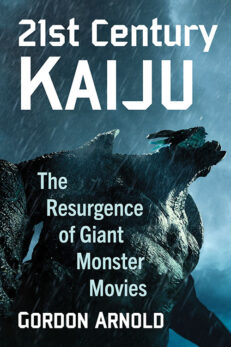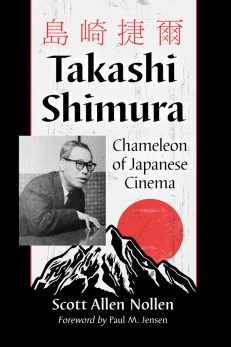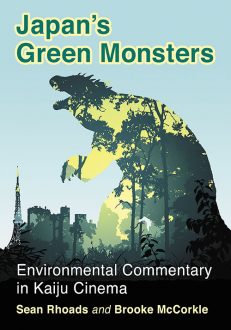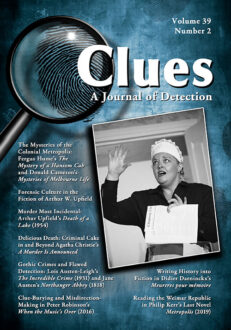Clues: A Journal of Detection, Vol. 39, No. 2 (Fall 2021)
Print Back Issue$30.00
In stock
About the Book
BACK ISSUE
This is a single back issue only. To order a current subscription, or for more information, please visit the journal’s web page at CluesJournal.com. Back issues from earlier volumes of Clues are available for order subject to availability. Also, single issues of the current volume may be ordered one at a time. Individuals may order back issues directly from our online catalog, and the charge for individuals is $30 (excluding postage). Issues from Volume 33 to the present are also available in ebook format on Kindle, Nook and Google Play.
The charge for single issues for institutions is $75 per issue (excluding postage). If your institution requires a back issue, please contact us to order at the appropriate rate.
About the Author(s)
Bibliographic Details
Executive Editor Caroline Reitz
Managing Editor Elizabeth Foxwell
Consulting Editor Margaret Kinsman
Format: softcover (7 x 10), back issue
Pages:
Bibliographic Info:
Copyright Date:
ISSN 0742-4248
Imprint: McFarland
Table of Contents
Introduction: So Many Books, So Little Time
caroline reitz 5
Caroline Reitz, the new executive editor of Clues, provides an overview of the issue, including articles on authors such as Lois Austen-Leigh, Raymond Chandler, Agatha Christie, Didier Daeninckx, Fergus Hume, Philip Kerr, Peter Robinson, and Arthur Upfield.
Australian Rules: Forensic Culture in the Fiction of Arthur W. Upfield
betty j. bruther 9
Four novels in Arthur W. Upfield’s Napoleon Bonaparte series—Winds of Evil (1937), Death of a Swagman (1946), The Widows of Broome (1950), and The Bachelors of Broken Hill (1950)—deal with multiple murders committed by a single individual in the outback. Each novel reveals the forensic culture of Australia: common investigative techniques, criminal profiling, forensic psychology, and the examination and interpretation of temporary trace evidence on the landscape.
Murder Most Incidental: Arthur Upfield’s Death of a Lake (1954)
rachel franks and alistair rolls 19
Arthur Upfield is well-known for positioning an Aboriginal detective, Inspector Napoleon “Bony” Bonaparte, as the protagonist for his series. In Death of a Lake (1954), Upfield challenges the conventions of mid-twentieth-century Australian crime stories not only through privileging an Indigenous man but also through disregarding the central concept of the modern crime novel: murder.
The Mysteries of the Colonial Metropolis: Fergus Hume’s The Mystery of a Hansom Cab and Donald Cameron’s Mysteries of Melbourne Life
orla donnelly 30
Fergus Hume’s The Mystery of a Hansom Cab (1886) and Donald Cameron’s Mysteries of Melbourne Life (1873) follow the tradition of urban crime writing. This essay examines three essential elements in these Melbourne crime novels: the treatment of crime and detection, the themes of physical and social mobility, and the exoticized images of urban street folk.
Death in a Literary Context: Detective Novels of the Golden Age as Enacted Criticism
andrew green 41
This article explores the nature of Golden Age crime narrative. It argues that the works of these authors are “enacted criticism”—creative acts that are fundamentally critical responses to genre—that can be read as mutually constitutive meaning-making “spaces”—texts within which form is constantly renegotiated within a literary context.
Clue-Burying and Misdirection-Making in Peter Robinson’s When the Music’s Over (2016)
christiana gregoriou 51
Close stylistic inspection of detective novel writing can shed light on the skill of weighing up interpretations. In When the Music’s Over, Robinson relies on readers’ schematic expectations, stereotypes, and prejudices to generate false leads and bury a killer into the narrative background until his significance needs to be foregrounded.
Writing History into Fiction in Didier Daeninckx’s Meurtres pour mémoire
john gleeson 60
This article demonstrates Didier Daeninckx’s unique blending of historical fact and fiction, particularly the use of state archives in his breakthrough novel Meurtres pour mémoire (1984). It also examines intertextual references to nineteenth-century writers and the French New Wave cinema that expand the traditional boundaries of the genre.
History Detective: Reading the Weimar Republic in Philip Kerr’s Last Novel Metropolis (2019)
neil h. donahue 71
Philip Kerr’s last novel Metropolis (2019) returns his detective, Bernie Gunther, to 1928 as both prequel and epilogue to his series of 14 novels. This essay locates the key to Gunther’s identity and actions in his relation to arch-Nazi Arthur Nebe.
Gothic Crimes and Flawed Detection: Lois Austen-Leigh’s The Incredible Crime (1931) and Jane Austen’s Northanger Abbey (1818)
lee o’brien 84
Lois Austen-Leigh’s The Incredible Crime, a Golden Age crime novel republished in 2017, cleverly exploits Jane Austen’s parody of gothic conventions in Northanger Abbey, importing her famous forebear’s revisionary irony into her own plot with subversive consequences.
Desire and Nonhuman Excess in Raymond Chandler’s The Big Sleep
chris hall 95
This article reexamines Raymond Chandler’s The Big Sleep (1939) via key psychoanalytic conceptualizations of desire. In doing so, it makes the case that analysis of desire in the novel has yet to satisfactorily account for desire’s excessive manifestations, which constitute a machinery that throws the novel’s bodies into question.
Delicious Death: Criminal Cake in and Beyond Agatha Christie’s A Murder Is Announced
christopher yiannitsaros 107
This essay analyzes the intersection of food and crime in Agatha Christie’s A Murder Is Announced (1950). Set during postwar rationing, the novel turns on a decadent chocolate cake created with illegally acquired ingredients, thereby becoming a vector for Miss Blacklock’s “serious” crimes of fraud and murder. It concludes by considering Jane Asher’s 2010 re-creation of the cake.
REVIEWS
Martin Edwards, ed. Howdunit: A Masterclass in Crime Writing by Members of the Detection Club. monica lott 119
Christopher Breu and Elizabeth A. Hatmaker, eds. Noir Affect. clare rolens 120
Brian Cliff. Irish Crime Fiction. diane m. calhoun-french 122
Elizabeth Mannion and Brian Cliff, eds. Guilt Rules All: Irish Mystery, Detective, and Crime Fiction. peter dempsey 124
Call for Papers, Borders and Detective Fiction 126
Clues Index, Volume 39 127
Book Reviews & Awards
- “Clues is a must-have for readers and writers of crime fiction. Scholarly, thought-provoking, wide-ranging in its topics, Clues covers the crime and thriller map.”—Sara Paretsky
- “A. Conan Doyle, notoriously resentful of Sherlock Holmes’s success, liked to scorn ‘police romances’ as less significant and worthy of his talents than his other literary work. If he could have read Clues, the thinking mystery reader’s journal, he would surely have felt differently—and learned much he never realized himself about even his own landmark contribution to the genre, from which so much else by others has flowed.”—Jon Lellenberg, U.S. agent for the Arthur Conan Doyle estate
- “I love reading Clues. Every issue provides thought-provoking, well-researched articles. The variety and scope of the material found in Clues makes an unparalleled, ongoing contribution to our understanding of the role of crime fiction in our culture, and the genre’s reflection of its time and society.”—Jan Burke, Edgar-winning author of The Messenger (2009)
- “Clues is an important journal. It carries the torch of tradition that is the backbone of detective fiction. It goes below the surface and gets to the heart of what makes the genre so fascinating and valid today”—Michael Connelly, author of the Harry Bosch novels, including The Overlook (2007)
- “for erudite and fascinating truths about mysteries, follow the clues to Clues, the scholarly journal that is an essential resource for every serious student of the mystery”—Carolyn Hart, author of Death Walked In (2008)
- “with scholarship ranging from Poe to Peters, nothing beats Clues”—Joan Hess, author of Mummy Dearest (2008).





